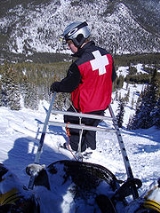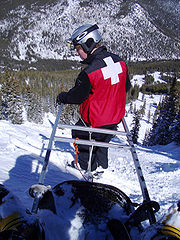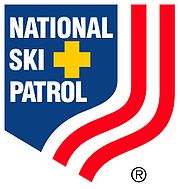
Ski patrol
Encyclopedia

Emergency medical services
Emergency medical services are a type of emergency service dedicated to providing out-of-hospital acute medical care and/or transport to definitive care, to patients with illnesses and injuries which the patient, or the medical practitioner, believes constitutes a medical emergency...
and rescue services to skiers
Skiing
Skiing is a recreational activity using skis as equipment for traveling over snow. Skis are used in conjunction with boots that connect to the ski with use of a binding....
and participants of other snow sports, either at a ski area or in a back country setting. Patrollers are trained in Basic
Basic life support
Basic life support is the level of medical care which is used for patients with life-threatening illnesses or injuries until the patient can be given full medical care at a hospital. It can be provided by trained medical personnel, including emergency medical technicians, paramedics, and by...
or Advanced Life Support
Advanced Life Support
Advanced Life Support is a set of life-saving protocols and skills that extend Basic Life Support to further support the circulation and provide an open airway and adequate ventilation .-Components of ALS:These include:...
to stabilize and transport patients to definitive care
Emergency department
An emergency department , also known as accident & emergency , emergency room , emergency ward , or casualty department is a medical treatment facility specialising in acute care of patients who present without prior appointment, either by their own means or by ambulance...
, often with the same capabilities as in an ambulance. Patrollers can be EMT-B
Emergency medical technician
Emergency Medical Technician or Ambulance Technician are terms used in some countries to denote a healthcare provider of emergency medical services...
s, or the equivalent of their nation's ski patrol training, and/or OEC technicians
Outdoor Emergency Care
Outdoor Emergency Care is an award winning course that was first developed by the National Ski Patrol in the 1980s for certification in first aid, CPR and other pre-hospital care and treatment for possible injuries in non-urban settings...
, EMT-Is or Paramedics. Due to the remote location and terrain, transportation is often limited to toboggan
Toboggan
A toboggan is a simple sled which is a traditional form of transport used by the Innu and Cree of northern Canada. In modern times, it is used on snow to carry one or more people down a hill or other slope for recreation. Designs vary from simple, traditional models to modern engineered composites...
, snowmobile
Snowmobile
A snowmobile, also known in some places as a snowmachine, or sled,is a land vehicle for winter travel on snow. Designed to be operated on snow and ice, they require no road or trail. Design variations enable some machines to operate in deep snow or forests; most are used on open terrain, including...
, snowcat
Snowcat
A snowcat is an enclosed-cab, truck sized, fully tracked vehicle designed to move on snow. Snowcats are often referred to as 'trail groomers' because of their use for grooming ski trails or snowmobile trails...
, and helicopter
Helicopter
A helicopter is a type of rotorcraft in which lift and thrust are supplied by one or more engine-driven rotors. This allows the helicopter to take off and land vertically, to hover, and to fly forwards, backwards, and laterally...
. Patrollers are often well versed in avalanche
Avalanche
An avalanche is a sudden rapid flow of snow down a slope, occurring when either natural triggers or human activity causes a critical escalating transition from the slow equilibrium evolution of the snow pack. Typically occurring in mountainous terrain, an avalanche can mix air and water with the...
search and rescue and other specialized techniques (e.g., chairlift
Chairlift
An elevated passenger ropeway, or chairlift, is a type of aerial lift, which consists of a continuously circulating steel cable loop strung between two end terminals and usually over intermediate towers, carrying a series of chairs...
evacuation, helicopter rappelling). Patrols work to promote ski safety, enforce area policies (where applicable), and help injured skiers when necessary. Ski patrollers also work to set up the mountain before it opens by conducting trail checks, providing avalanche control work, and setting up necessary equipment in preparation for the day. At the end of the day they also conduct a sweep clearing the mountain for off-hours.
Contrary to the name's implications, ski patrollers can be snowboarders
Snowboarding
Snowboarding is a sport that involves descending a slope that is covered with snow on a snowboard attached to a rider's feet using a special boot set onto mounted binding. The development of snowboarding was inspired by skateboarding, sledding, surfing and skiing. It was developed in the U.S.A...
in addition to alpine
Alpine skiing
Alpine skiing is the sport of sliding down snow-covered hills on skis with fixed-heel bindings. Alpine skiing can be contrasted with skiing using free-heel bindings: Ski mountaineering and nordic skiing – such as cross-country; ski jumping; and Telemark. In competitive alpine skiing races four...
, telemark
Telemark skiing
Telemark skiing is a form of skiing using the Telemark turn. Unlike alpine skiing equipment, the skis used for telemarking either have a binding that only connects the boot to the ski at the toes, just as in cross-country skiing, or may be released to only connect there.Telemark turns are led with...
, or Nordic
Cross-country skiing
Cross-country skiing is a winter sport in which participants propel themselves across snow-covered terrain using skis and poles...
skiers. Many patrols also have non-skiing positions whereby patrollers no longer able to ski or lacking the skiing skills to handle toboggans can still provide emergency care in a first aid room
First aid room
A first aid room or medical room is a room in an establishment to which someone who is injured or taken ill on the premises can be taken for first aid and to await the arrival of professional emergency medical services.A first aid room should be clearly signposted, easily accessible and contain:*...
. Some ski areas also have a junior ski patrol program in which teenagers between the ages of 15 and 18 years old can participate. Most junior ski patrol programs limit the responsibilities of their members, such as preventing them from running toboggans or administering first aid without supervision. However, there are some ski areas with junior ski patrol programs which allow their members to operate with the same responsibilities as the rest of the patrol.
First Aid Committee -1933
In 1933 the Schenectady (New York) Wintersports Club was organizing Snow Trains for local skiers to go to the Gore Mountain-Pate Gay Massif above North Creek, New York to enjoy skiing on trails cut by local sports enthusiasts as well as from Schenectady. Because of tales learned of injured skiers on the early (1931) Boston to New Hampshire (Franconia) Snow Trains, the organizers decided to have a large and well prepared First Aid Committee. Headed by Lois Perret (Schaefer), RN, and aided by expert skiers from the Schenectady Wintersports Club, as well as North Creek High School students, a course on first aid and ski related injuries was taught to several dozen recruits. The Snow Trains were delayed because of a lack of snow in 1933/1934, but sufficient snow cover was achieved late, and the first Snow Train reached North Creek March 4, 1934. The First Aid Committee swung into action, sweeping trails for skiers needing assistance. The train acted as a base camp on the siding during the day. While no injuries were treated on that first trip, the First Aid Committee (AKA Ski Patrol) continued active participation on trains reaching North Creek during the pre-war years. They were assisted by a "physician-on-call," Dr. Woodhall, a skier who served as head of surgery at Albany Medical Center. The First Aid Committee of 1933 anticipated the much needed assistance pioneered by Minnie Dole five (5) years later in conjunction with care for injured ski racers who were pushing limits of speed and technique. The first ski patrol was about helping mountainside injuries to regular ski enthusiasts—not racers.National Ski Patrol

National ski patrol
The National Ski Patrol is the largest winter rescue organization in the world. It was founded in 1938 by Charles Minot Dole, at the urging of Roger Langley...
(NSP) is the patrol governing body for the United States and some portions of Canada and Europe. The organization was founded in 1938 by the NSP's first chairman, Charles Minot Dole
Charles Minot Dole
Charles Minot "Minnie" Dole was the founder of the National Ski Patrol.Minnie Dole formed the National Ski Patrol in 1938 and was director of the organization until 1950....
. "Minnie," as he was known, decided that a "service and safety" organization was in order after he hurt himself skiing at Stowe, VT and had trouble evacuating himself from the slope. He created the Mount Mansfield Ski Patrol for the National Downhill and Slalom Championship at Mt. Mansfield. Roger F. Langley the president of the National Ski Association asked Dole to consider a national patrol. Dole later went on to create the 10th Mountain Division
10th Mountain Division
The 10th Mountain Division is a light infantry division of the United States Army based at Fort Drum, New York. It is a subordinate unit of the XVIII Airborne Corps and the only division-sized element of the U.S. Army to specialize in fighting under harsh terrain and weather conditions...
after seeing Finnish soldiers on skis destroy two armored divisions. One of the few federally chartered not-for-profit organizations in the U.S., the NSP has since become the world's largest winter rescue organization. The NSP's 26,500 paid and volunteer members serve on over 600 patrols.
The NSP is composed of 10 geographic divisions plus a single division for all paid patrollers. Members are recognized on the slopes by the red jackets they wear marked by a white cross on the chest and a larger one on the back, or by the older style of blue and rust colored parkas with yellow crosses.
Merits, Awards and Ranking; The levels of the National Ski Patrol are 1.Auxiliary 2.Patroller (Basic) 3.Senior 4.Certified. There are also levels of personal achievement given to a Ski Patroller who goes beyond the call of duty is awarded the Yellow Merit Star. The highest Honor of the National Ski Patrol is the Purple merit star, this is awarded for saving a life.
National Ski Patrol has an ongoing education system which includes OEC refreshers, Ski Lift evacs and OEC classes, and has grown into an authority on outdoor emergency care. In most cases an Outdoor Emergency Tech (OEC) is equivalent to EMT status.
Over the course of its history, the NSP has helped to develop similar patrol organizations in Canada, New Zealand, Australia, Argentina, Chile, Israel, Turkey and Korea.
Canadian Ski Patrol System
The Canadian Ski Patrol SystemCanadian Ski Patrol System
The Canadian Ski Patrol System is an organization made up of over 5000 volunteer and paid alpine skiers, telemark skiers, snow boarders, and Nordic skiers that provides safety and rescue services...
is the patrol governing body for Canada.
In 1940, Dr. Douglas Firth was asked by the Canadian Amateur Ski Association (CASA) to organize and train a first aid rescue group to patrol the ski hills. The Canadian Ski Patrol System was originally a standing committee of the CASA with independent patrols in different areas. During the years between 1941 and 1948, the war restricted expansion, but the Toronto and Montreal Patrols united to form the nucleus of a national organization. During the next five years, the System expanded in Ontario, Quebec and the Vancouver area.
The founder and President of the Quebec area was led by James Harold Millard, a resident of Montreal and Morin Heights. Harold became National Chairman for Canada, following Dr Firth.
In the early years, those who were injured were taken down the hill on a toboggan where they were then loaded onto the train for transportation to Montreal for medical care. Many photos of the original patrol in Quebec were turned over to the CSPS in the late 90s for their archives.
The family tradition continued when both Harold's daughter-in-law and grandson were members of the CSPS in Ontario and Alberta.
By 2004, the Canadian Ski Patrol had 5,000 members across Canada.
The CSPS is composed of nine geographic divisions. Members are recognized by the yellow and blue jackets they wear marked by a blue maple leaf superimposed with a yellow cross. (Note: This is not the same as the marketing logo.) Different logos are made at different times.
See also
- Emergency medical technicianEmergency medical technicianEmergency Medical Technician or Ambulance Technician are terms used in some countries to denote a healthcare provider of emergency medical services...
- Mountain rescueMountain rescueMountain rescue refers to search and rescue activities that occur in a mountainous environment, although the term is sometimes also used to apply to search and rescue in other wilderness environments. The difficult and remote nature of the terrain in which mountain rescue often occurs has resulted...
- Wilderness first aid
- LifeguardLifeguardA lifeguard supervises the safety and rescue of swimmers, surfers, and other water sports participants such as in a swimming pool, water park, or beach. Lifeguards are strong swimmers and trained in first aid, certified in water rescue using a variety of aids and equipment depending on...
External links
- National Ski Patrol
- Professional Ski Patrol Association
- Fédération Internationale des Patrouilles de Ski / International Federation of Ski Patrollers
- Australian Ski Patrol Association
- British Association of Ski Patrollers
- Canadian Ski Patrol System
- Snowvalley Ski Patrol - Barrie Ontario
- Swiss Ski Patrol
- Serbian Ski Patrol
- (US) Loon Mountain Ski Patrol
- (US) Mt. Baldy Ski Patrol
- (US) Mt. Holly Ski Patrol
- (US) Mt. Pinos Nordic Ski Patrol
- http://teachski.com/articles/nsp/nsp.htm
- http://www.drum.army.mil/sites/about/hist-10mtn.asp

